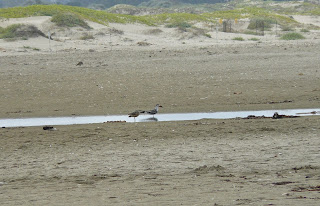"One good Tern deserves another." And another, and another. The plan for the morning birding was to look for shore birds that had been observed in the vicinity of the lagoon that spreads on to the beach at the south end of Morro Strand campground. Our view as we (Mike Baird and I) neared the beach was of thousands of extremely vocal Elegant Terns. We were in total amazement, momentarily forgetting about shore birds.
The sound of a giant flock of Elegant Tern chattering is a "wonder" of the birding world.
On this overcast August morning the beach was quiet. To the north and to the south flocks of Elegant Terns. Moments after we arrived we saw a Caspian Tern. Following the Caspian was a fussing adolescent. I clearly heard it say, "Feed me, Feed me."
On the fringe of the Elegant Tern flock was a smaller flock of Heermann's Gull; along the outer edge of the Gull flock were two Royal Terns (above), an adult and an adolescent begging for food.
I watched an adult Elegant Tern with a small silvery fish gripped in her bill circle over the flock, calling and calling. She circled many times. Finally her youngster rose into the air and followed her away from the flock. They landed and the youngster took the fish.
Eventually, we birded the lagoon. Greater and Lesser Yellowlegs, Wilson's and Red-necked Phalarope, Semi-palmated Plover, Western Sandpiper, Killdeer, Long-billed Curlew, and here and there Ring-billed Gull (below).
We met up with Meg, who monitors nesting Snowy Plover. She said a Black Skimmer had been seen on the edge of a flock of gulls. As we stood talking, suddenly she pointed up. A Black Skimmer was flying over us. They are a seldom seen bird on the central coast. Before landing it swooped over the lagoon to skim the surface for edibles. Skimmers feed by flying low with bill open, dipping the lower mandible into the water. Super treat seeing the Skimmer. First time sighting for Meg and Mike.
The Black Skimmer is in the center of the photo, to the left is a Willet. On the Morro Strand State Beach, the nesting Snowy Plover
is protected and watched over by State Park monitors. Dogs are not
allowed, and the dunes are cordoned off. Temporary wire cages protect
the Plover nests from predators. In the background of the photo is a nesting cage. The Snowy Plover (below) can go in and out at will, but predators cannot.
The highlight of the morning -- being surrounded by thousands of swirling, swooping clouds of excited Terns and Gulls -- one moment they were resting and preening on the beach, the next moment they were in flight. After a few minutes they landed and they were back to resting, preening which they do with gusto, and feeding their offspring. Click on the link to see the swirling mass of Terns.
https://youtu.be/qpw9CSTvS0A
Subscribe to:
Post Comments (Atom)






So many new things to learn from you .The nesting cage where the small birds can go in and out freely but predators an not is amazing.I would never have thought of such thing.
ReplyDeleteHi Lina. The nesting cages work very well. The plovers are tiny and have no problem going in and out of the cages. Besides people and dogs who would step on the nests, the predators are skunks, foxes, Gulls, crows, snakes.
ReplyDeleteThank you for looking at my blog. joyce
ReplyDelete